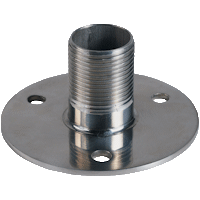How do I mount the marine antenna for my boat’s cell signal booster?
A cell signal booster requires an outside donor antenna to send and receive signal to and from the cell tower. Signal boosters for boats and ships use marine-grade antennas that mount to the deck, a rail, the mast, the radar arch, or other fixed location.
Mounting location
You’ll need to carefully consider your antenna’s mounting location. Where to place your antenna is a balancing act; you’ll need to keep in mind:
- The outside antenna will need to be mounted high enough to pick up signal from distant cell towers. The higher you can mount it, the better reception you’ll get.
- You’ll need adequate vertical separation between the outside antenna and inside antenna to prevent signal feedback (oscillation). A mobile booster like the Marine weBoost Drive Reach or Marine SureCall Fusion2Go XR will need about ten feet of antenna separation.
- The outside antenna will need to be mounted close enough to the booster so you can connect the two with a coax cable. Always use the shortest run of cable possible to limit signal loss (attenuation).

Types of marine mounts
You’ll need a marine mount with a 1″ × 14 thread, the standard thread size for marine antennas.
If your antenna has an N‑female connector and you plan to use low‑loss 400‑type coax cable with N‑male connectors, your marine mount will need to have a cable slot that allows the cable to pass through the bottom of the threads.
We recommend using a stainless steel mount for strength and durability.
There are four types of marine mounts:
Flange mount/flat mount
A flange mount is the simplest type of marine mount. It bolts to the deck or other level surface.
Flange mounts often do not have a cable slot, so they work best with marine antennas that have a side exit for the coax cable (like the RFI 38″ CDQ7199, the RFI 82″ CDQ7195, and the Poynting OMNI‑493).
Recommended flange mounts include the Shakespeare 4365 and the Poynting BRKT-37
and the Poynting BRKT-37 .
.
Ratchet deck mount
A ratchet deck mount bolts to a deck or the side of the vessel. It features a handled ratchet that allows you to set up and take down the antenna quickly and easily to sail beneath bridges and other low-clearance areas.
Recommended ratchet deck mounts include the Shakespeare 4187 (which has a cable slot) and the Poynting BRKT-39
(which has a cable slot) and the Poynting BRKT-39 (which does not).
(which does not).
Ratchet rail mount
A ratchet rail mount clamps to a 7⁄8″–1″ rail or pole. The rail can be horizontal, vertical, or angled. This mount also has a handled ratchet for quick and easy set up and take down of the antenna.
Recommended ratchet deck mounts include the Shakespeare 4190 (which has a cable slot) and the Poynting BRKT-38
(which has a cable slot) and the Poynting BRKT-38 (which does not). The cable slot on the Shakespeare 4190 is on the same side as the handle; 400‑type coax is too rigid to make the tight turn, so a jumper cable may be needed. (Contact us if you require this option.)
(which does not). The cable slot on the Shakespeare 4190 is on the same side as the handle; 400‑type coax is too rigid to make the tight turn, so a jumper cable may be needed. (Contact us if you require this option.)
Powerful Signal offers the Shakespeare 4190 as an optional add on in its marine cell signal booster kits.
Mast mount
A mast mount clamps the antenna to the top of a mast. You’ll need enough cable to run down the mast to the cell signal booster; often this means using low‑loss 400‑type coax.
If the bottom of the threaded mount is open, you may be able to pass a cable through it. If you’re using 400‑type coax, a jumper cable may be needed. (Contact us if you require this option.).
Recommended mast mounts include the Shakespeare 4715 and the Shakespeare 4366-R
and the Shakespeare 4366-R .
.








